The following was written by Amanda Kistler, an international accompanier from 2008 – 2009 with NISGUA. She was based out of Guatemala City and accompanied the plaintiffs in the Choatalúm trial. This article originally appeared on NACLA. Original article can be found here.
On August 31, a tribunal in Chimaltenango, Guatemala, sentenced former military commissioner Felipe Cusanero Coj to 150 years in prison. Cusanero’s conviction for surreptitiously kidnapping and murdering six Guatemalan citizens in the early 1980s, keeping their whereabouts and fate concealed, marks the first time in Guatemalan history that a court has found a member of the military guilty of a crime against humanity. It is also the first time a Guatemalan court has acknowledged the state’s specific use of forced disappearance, which claimed the lives of some 45,000 people during the country’s 36-year internal armed conflict (1960–96), according to the report published by the United Nations–sponsored Truth Clarification Commission (CEH) in 1999.
The effort to bring Cusanero to justice began in 2003, when, after almost two decades of silence, a group of surviving family members from the highland community of Choatalúm dared to do the unthinkable: They publicly denounced Cusanero and took him to court. Before then, continuing threats of disappearance and lists of suspected subversives compiled by the military had prevented people from coming forward. There was a shift, however, with the publication of two truth commission reports in 1998 and 1999, together with two national cases in 2000 and 2001 accusing former dictators Romeo Lucas García and José Efraín Ríos Montt, respectively, of committing acts of genocide during the conflict, along with their highest military commanders. In 2003, as Ríos Montt campaigned for president despite these allegations, the Choatalúm victims and their lawyers from the Center for Human Rights Legal Action (CALDH) chose to act.
Like many predominantly indigenous Guatemalan villages, Choatalúm—a community of more than 500 Maya Kaqchiquel families in San Martín Jilotepeque municipality, in the department of Chimaltenango—came under attack during the army’s intensely violent counterinsurgency campaign begun in September 1981 under Lucas García and continued until October 1982 by Ríos Montt. The army committed hundreds of massacres during the scorched-earth campaign, targeting civilians in the countryside to eliminate support for the guerrillas. Chimaltenango saw the fourth-highest percentage of human rights violations during the conflict, with San Martín Jilotepeque being one of the most affected municipalities, according to the CEH.
Most of the Choatalúm community, like hundreds of thousands of other displaced indigenous peasants in Guatemala during this time, fled into the mountains. Many had returned by 1982, when Choatalúm was converted into a “model village”—that is, a military colony—under Ríos Montt’s “rifles and beans” program, aimed at “pacifying” highland villages by providing food to communities that pledged their allegiance to the military and threatening anyone else with death. Model village inhabitants were subjected to heightened surveillance, being required to live in specific areas and to publicly present themselves when traveling. Men in the communities were forced to join Civil Self-Defense Patrols (PACs) and sent to patrol for guerrillas, serving as a kind of human shield against insurgent attacks.
Within the militarized structure of model villages, military commissioners were the lowest-ranked army officials, yet they exercised almost unlimited power at the local level and held command responsibility over the PACs. They organized and controlled the civilian population, as well as local authorities, providing intelligence to the army’s central command. Cusanero, a longtime Choatalúm resident, was military commissioner of the town during the internal armed conflict. He worked out of an army base installed on a hill in the center of the town, where, according to witness testimonies at the trial, rape, torture, and summary executions took place. Forced disappearance was one of the key tactics employed by the army to root out suspected guerrilla sympathizers in the model villages.
After the case against Cusanero was filed, it was mired for five years in the investigation phase handled by the public prosecutor (where most legal proceedings stagnate or dissolve). Public hearings finally opened in March 2008. Within weeks, Cusanero’s public defender introduced a legal stay, arguing that the case violated Guatemala’s constitutional law against retroactive prosecution, since the crime was committed well before 1996, when forced disappearance was formally outlawed in Guatemala. The hearings were suspended for 14 months (beyond the maximum length of time stipulated in the Penal Code) until July 7, when the Constitutional Court, the country’s highest, overruled the defense, declaring that forced disappearance could be tried today because the crime continues to be committed, since none of the victim’s remains have been located. “It is not when the crime began,” the court ruled, “but when it stops being committed.”
The 10 witnesses in the Choatalúm case testified despite receiving threats both during and after the trial. Cusanero’s lawyer accused them of outright lying and even argued that Cusanero had never been a military commissioner—a statement that caused many in the packed courtroom to visibly cringe. Men who were forced to serve in the PAC under Cusanero’s command hissed their contempt. When the judge later announced that the witnesses’ testimonies were considered “trustworthy and effective,” the whole room seemed to exhale. Heads turned in the audience as those who had testified sought the eyes of others in affirmation. Many blinked back tears. Handkerchiefs were pressed to noses.
More than 50 people from the communities of Chimaltenango came to witness the trial, as well as a dozen national and international human rights organizations, various local and international press outlets, and ambassadors from the United States, Chile, and Holland. Three judges made up the tribunal, one of whom, the “presidential judge,” announced their conclusions to the audience. In addition to the witnesses, the judges heard the testimony of Renaldo Leonel Acevedo Álvarez, a forensic anthropologist responsible for exhuming and analyzing the objects buried at the Choatalúm military base.
Although the exhumations did not find the bodies of the disappeared in question, forensic evidence like shattered bones, blindfolds, and gags suggested torture had occurred at the base. Witness testimonies were the most valuable evidence in the case, especially within the historical context corroborated by the CEH findings, the judges later declared.
The day of the verdict, a chartered bus drove community members to the court. Unlike other mornings, people were quiet and didn’t joke around. They bounced quietly in their seats as the bus made its way over the uneven road to the city. Waiting outside the courtroom, one woman from another community, who preferred anonymity for safety reasons, recounted how her own husband was disappeared in the 1980s and said she still lives in fear and uncertainty.
“If we win today,” she said, “it will give the rest of us the courage to start talking about the forced disappearances we have suffered.”
Inside, the chairs in the tiny courtroom quickly filled, and audience members crammed themselves into every available nook to watch. The temperature rose in the crowded, stuffy room. News cameras captured the scene, capitalizing on people’s exposed raw emotions. After a seven-hour deliberation, the presidential judge announced that the tribunal considered “the evidence . . . sufficient to destroy the state of innocence enjoyed by Felipe Cusanero Coj.” As military commissioner of Choatalúm, Cusanero was found guilty of voluntarily planning, ordering, and executing the forced disappearance of Santiago Sutuj, Alejo Culajay Ic, Lorenzo Ávila, Filomena López Chajchaguin, Encarnación López López, and Mario Augusto Tay between November 1982 and October 1984. He was sentenced to 25 incommutable years in prison for each crime.
When the judge finished speaking, there was a commotion at the front of the room as six police officers converged on Cusanero, handcuffing him and leading him out of the room in the midst of a press frenzy. The audience stood respectfully as the judges filed out. Then someone began clapping. In a second, the whole room erupted in applause, crying and hugging. A few cries of “Que viva la justicia en Guatemala!” rang out. “Long live justice in Guatemala!”
The plaintiffs of Choatalúm had achieved the most important legal precedent to date in the fight to hold Guatemala’s military accountable for its atrocities.
*
Forced disappearance was first used as a government-sanctioned tactic of mass political repression in Nazi-occupied territories during World War II, according to a 1983 Amnesty International study. Under the Nacht und Nebel (Night and Fog) decree of 1941, the Third Reich cracked down on resistance movements and intimidated the general population by “disappearing” any suspected resistance members or collaborators. By leaving no trace of the victims’ existence or information about their whereabouts, the Nazis aimed both to terrorize the population and to avoid creating martyrs.
Guatemala became the first Latin American country to systematically employ forced disappearance in the 1960s, during the first phase of the armed conflict. The tactic was subsequently used during the next two decades in counter-insurgency campaigns in Argentina, Bolivia, Brazil, Chile, Colombia, El Salvador, Haiti, Honduras, Mexico, Peru, and Uruguay. Between 1966 and 1986, more than 90,000 people were forcibly disappeared in Latin America—almost half of them in Guatemala—according to Amnesty International estimates.
Not coincidentally, the Latin American states that deployed forced disappearance and other repressive measure during the 1970s adopted a Nazi-like national security doctrine (NSD) that established the state as an entity separate from the rest of society whose primary function was self-protection. The NSD defined anyone who threatened the state as an enemy eligible for elimination and charged the military with guaranteeing the state’s security and well-being—effectively granting the army unrestricted power and placing its actions beyond recrimination by either the population or the legal system.
By the 1970s, many of Latin America’s highest-ranking military officials, trained at the Georgia-based School of the Americas, had returned to their respective countries and implemented the NSD against perceived enemies of the state. They violently repressed the general population, and selectively brutalized targeted individuals, to destroy social organizations and community cohesion. In following the NSD, Latin American militaries broke with traditional methods of territorial defense by effectively becoming armies of occupation within their own countries.
As the Guatemalan military’s Counter-Insurgency Manual of 1983 explained, destroying insurgent forces was “not an objective in and of itself” but rather “a means to reconquer the control of the civilian population.” Forced disappearance comprises about one fifth of recorded human rights violations in Guatemala during the conflict. Together with extrajudicial killings, public massacres, torture, rape, and forced displacement, it formed the basis of the military’s reconquering of Guatemalan citizens. According to the logic of “preventative war,” the state would eliminate any possible insurgency by terrorizing and neutralizing civil society—or, in the words of Ríos Montt’s scorched-earth refrain, by “taking away the water to kill the fish” (quitar el agua del pez).
Today, a legal definition of forced disappearance has been codified. Although it resembles the crime of unlawful detention or abduction, it differs from these in two important ways: First, forced disappearance is perpetrated by or with the support of a state or political organization, making it part of a systematic plan. Second, the fate of the abducted person is concealed in order to remove him or her from the protections of the law and cause terror and uncertainty in the wider population.
Because forced disappearance involves the violation of several human rights—including the rights to life, liberty, physical integrity, security, justice, due process, truth, and reparation—it is internationally classified as a crime against humanity. In 1983, the Organization of American States adopted Resolution 666, which establishes in Article 4 that “the practice of forced disappearance of persons in America is an affront to the conscience of the hemisphere and constitutes a crime against humanity.” The United Nations General Assembly adopted the Declaration for the Protection of All People Against Forced Disappearance in 1992, calling the crime “an offense to human dignity.”
Part of what makes forced disappearance so egregious is that it denies those who survive the opportunity to understand what happened and to honor those lost with a proper burial—a fundamental element of the healing process. Grieving becomes a permanent state. For Mayan victims, forced disappearance does violence to their form of spirituality in severing ties with the dead, which are an integral part of Maya beliefs. Recognizing this, the judge in the Choatalúm case called forced disappearance “one of the most perversely subtle, though no less violent, ways of affecting the conscience and dignity of human beings.”
The six cases against Cusanero were chosen as the most feasibly prosecutable, but they likely represent only a fraction of the people forcibly disappeared in the military zone of Choatalúm during the early 1980s. Internationally, few forced disappearance cases have reached a sentence, even though it has been explicitly outlawed. The Inter-American Court on Human Rights (IACHR) tried the first forced disappearances case in Latin America in 1988, when it condemned the state of Honduras for the forced disappearance of Ángel Manfredo Velásquez Rodríguez in 1981.
Since then, the IACHR has also found the states of Bolivia, Colombia, El Salvador, Guatemala, Panama, and Peru guilty of committing forced disappearances. Guatemala was sentenced in 1999 to pay reparations for the 1985 forced disappearance of the freelance journalist Nicholas Blake; thereafter, it took another full decade for Guatemala’s domestic courts to successfully prosecute their first case of forced disappearance with the Choatalúm case.
*
Although the Choatalúm plaintiffs achieved justice in the legal sense, they still have not achieved meaningful reconciliation, either in their community or in their hearts. The remains of the disappeared remain hidden, and exhumations of secret graves continue. Witnesses continued to receive death threats in the days following the sentencing, most likely from Cusanero’s family, friends, and supporters, who still live alongside the survivors.
And so, while the Choatalúm verdict represents an unprecedented achievement and a political victory, survivors expressed mixed emotions afterward. Cusanero refused to provide any information during the trial as to the whereabouts of the disappeared. Even before the trial, the community of Choatalúm had asked Cusanero on three occasions where the disappeared were buried, but he refused. As one witness, who preferred to remain anonymous for safety reasons, testified during the trial: “What I want is for Cusanero to tell the truth. What do I care if he goes to jail?”
Hilarión López, witness and father of one of the disappeared, echoed this sentiment at a press conference the day after the sentencing. “[Cusanero should ask for pardon from the people of San Martín, from the community of Choatalúm,” he said, as reported in La Hora, a Guatemalan daily. “What I want is justice. . . . I want to bring my son to the cemetery so I can bring him a flower arrangement and light a candle.”
Although the Choatalúm verdict could support future prosecutions of forced disappearance and other human rights abuses committed during the conflict, these cases still face many obstacles. Too many public figures and civil servants are reluctant to challenge those responsible because it involves accusing not just powerful individuals but also the systems that have granted them power, condoned their activities, and continued to protect them from blame. The legacy of impunity makes almost every assertion of truth to power a dangerous act.
In just the first eight months of 2009, more than 257 aggressions against human rights defenders were registered—an almost 17% increase over the total attacks the previous year, according to a report from the Human Rights Defenders’ Protection Unit, which monitors and investigates such attacks in Guatemala. In this dangerous context, only those truly committed to justice, like the judges, lawyers, and survivors involved in the Choatalúm case, have demonstrated the political will and courage to challenge the otherwise near total stranglehold of impunity.
In a press conference a day after the sentence, Mario Minera, director of the Center for Human Rights Legal Action based in Guatemala City, estimated that there were more than 100 cases of forced disappearance presented to the public prosecutor’s office, but the judges have classified the vast majority of them as kidnapping or abduction, which are not considered crimes against humanity and ignore the crime’s political implications.
Yet civil society is increasingly taking a stand. Human rights lawyers have already begun pushing the application of the Choatalúm precedent toward other forced disappearance cases. In the case of El Jute, Chiquimula, in which eight men were disappeared on October 19, 1981, the judge twice refused to broaden the accusation from kidnapping to forced disappearance during the hearings, despite the new legal precedent. The five accused, four ex–military commissioners (one deceased) and a colonel, had been held in preventative custody since 2005.
On December 3, despite having rejected changing the accusation, the judges declared the four men guilty of committing forced disappearance and crimes against humanity. The colonel, Marco Antonio Sánchez Samayoa, is now the first ranking military officer sentenced for war crimes in Guatemala. The judges also ordered an investigation into all those in the chain of command as high as former chief of state Benedico Lucas García (brother to the dictator Romeo Lucas García) and former defense minister Ángel Aníbal García for their responsibility in the crimes.
This investigation would parallel the national-level cases aiming to hold ex-dictators Lucas García and Ríos Montt accountable for acts of genocide. The cases have barely progressed since they began and remain stuck in the investigatory phase—like the 99% of war crimes that remain untried and unresolved, according to Archbishop’s Office on Human Rights in Guatemala. Human rights groups like CALDH and the Mutual Support Group, which provided logistical support to the witnesses in El Jute, hope the first forced disappearance convictions will bolster the validity of the genocide cases and encourage more victims to demand justice.
Although achieving full accountability for atrocities committed during the internal armed conflict in Guatemala remains a distant hope—especially as more time elapses and many of those responsible are getting older and will likely die before any prosecution—the first conviction for forced disappearance provides a first step. At the very least, the Choatalúm verdict, in its public recognition of the state’s use of forced disappearance and its validation of the testimonies of the survivors, ensures that the state can no longer ignore the 45,000 people disappeared during the conflict.
The legal process also gave voice to collective memories and histories that had been all but silenced. This public validation of historical memory is in some ways more powerful for the victims of human rights abuses than the conviction itself. The judge highlighted this during his explanation of the verdict. “The right to truth, in its collective dimension . . . is an act of justice and reparation in and of itself, he said, “and a fundamental step in order to understand how to move toward reconciliation.”
Or as Aura Elena Farfán, a co-plaintiff but not a witness in the Choatalúm case and a member of Families of the Disappeared and Detained of Guatemala, put it at a press conference September 1: “Although this is not about our own family members, justice affects us all.”
Amanda Kistler is an international human rights observer with the Network in Solidarity With the People of Guatemala (NISGUA). She is based in Guatemala City.

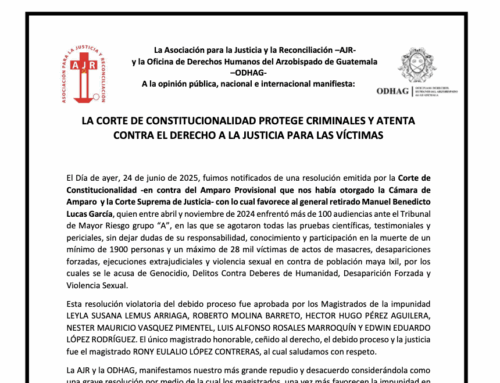
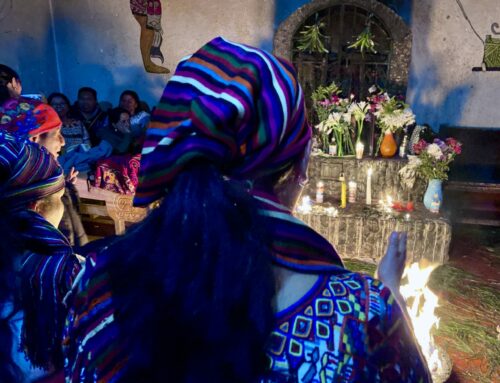
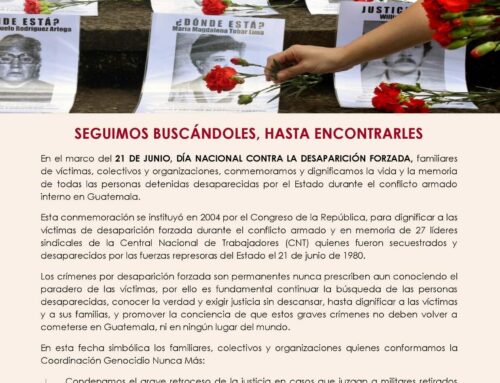
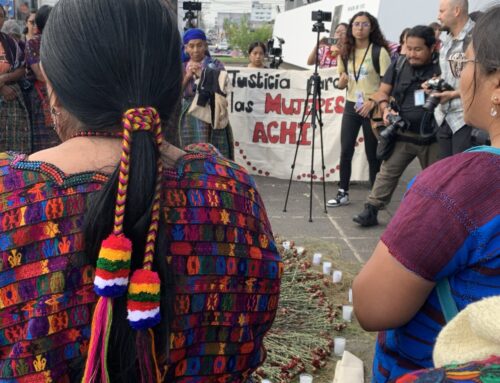
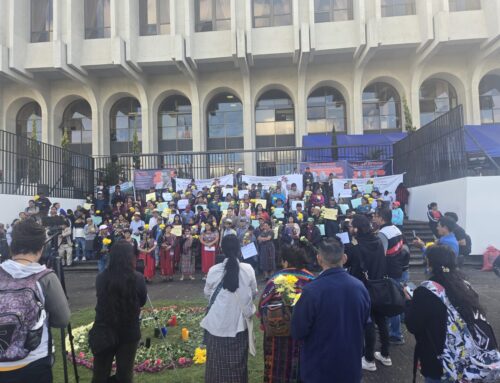
Leave A Comment